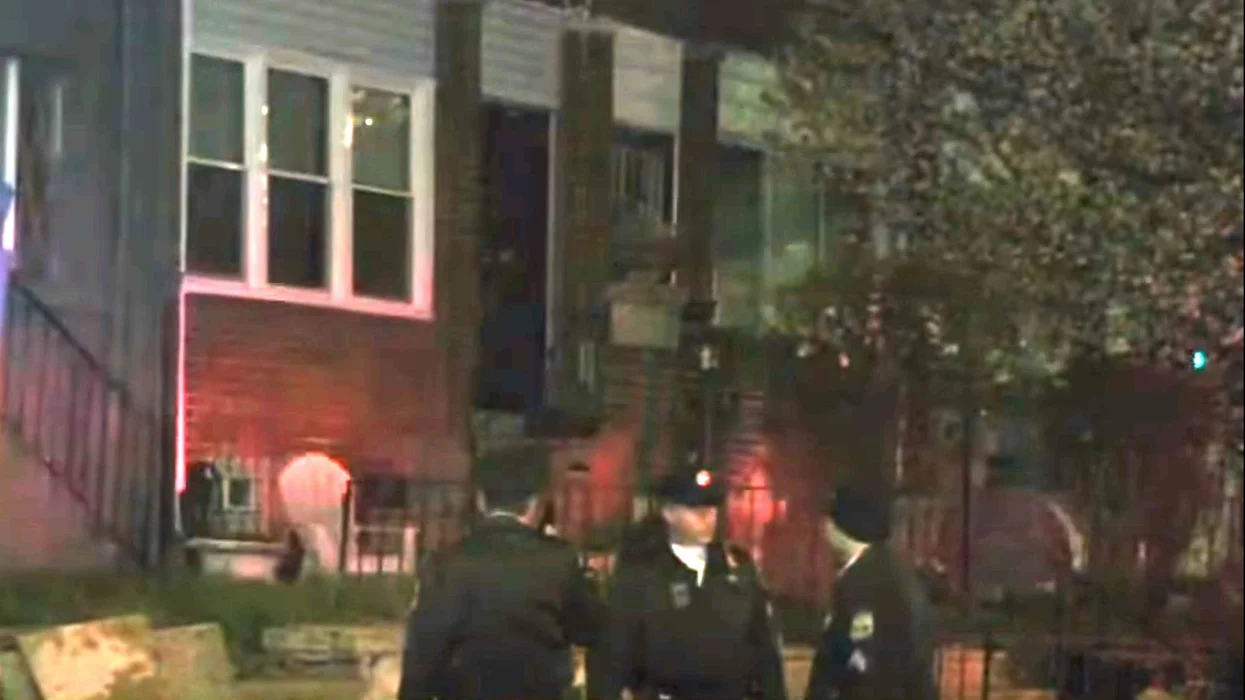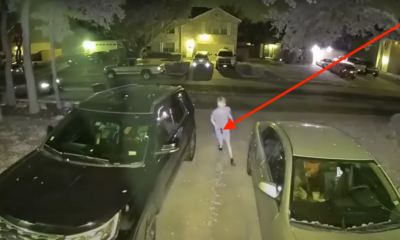Preparedness
Philadelphia Woman Fends Off Fake Cops, Leaves One Dead, One Injured

An alleged home invasion in Philadelphia took a deadly turn. According to Pennsylvania police, a woman and her boyfriend had just returned to her first-floor apartment on Chestnut, when they were ambushed by three armed men. The woman, demonstrating remarkable courage and quick thinking, managed to fire back, leaving one intruder dead and another injured.
Unpredictable danger came knocking when the woman and her boyfriend were accosted by the three men. Allegedly masquerading as police officers, with at least one of them sporting a badge around his neck, the intruders were able to surprise the couple. A brief scuffle ensued, during which a staggering 13 shots were exchanged.
The end result was devastating for the intruders. One of the assailants, a 32-year-old, was discovered in a bedroom. His injuries, which included a gunshot wound to the head and multiple chest wounds, proved fatal. He was declared dead on the scene. In the chaos, a second man managed to escape through a back door, but not before sustaining gunshot injuries to his shoulder. He later sought treatment at Mercy Hospital.
“He was arrested,” the police reported, but there was no additional information regarding the third unidentified intruder who made a successful escape.
Aaron Allen, a neighbor, shared his perspective with KYW-TV. He revealed that the woman had moved into the home with her family about a year before the incident. “She don’t bother nobody,” Allen stated. He expressed his concerns about the increasingly violent society, “People so mean. You don’t know what people might do.”
“Carrying guns and she probably was trying to defend herself and I don’t blame her,” he added.
Another neighbor, Tressy Wilson, echoed the sentiments of shock and fear. Having been assaulted in the same area, she admitted that the recent shooting was a chilling reminder of the ever-present danger. “That’s shocking. It makes no sense,” she said.
“I stay to myself. I’m scared to go to work. I’m scared to go home,” Wilson added. “Now you scared to be in your own house.”
Following the incident, the woman has been cooperating with the police. Questions have been raised regarding the nature of the relationship between the woman and the intruders. Initial reports revealed that the woman claimed not to know any of the assailants and was clueless as to why they targeted her.
The investigation is ongoing and it remains unclear whether the woman will face charges for her actions in self-defense.
Watch a local news report about the incident below:
Let us know what you think, please share your thoughts in the comments below.

Preparedness
Master Crisis Survival with the Rule of Three

In an unpredictable world, being prepared for emergencies is more than just a smart idea; it’s essential. Whether it’s a car accident in a remote location or getting stranded in the wilderness, knowing survival skills can make all the difference. However, it’s not enough to just learn these skills or own the right tools; you must also know how to prioritize them in a crisis.
Survival experts often refer to the Rule of Three when making decisions under pressure. This rule provides a guideline for how long you can survive without essential needs like air, shelter, water, and food. While there are variables, such as climate and individual size, the Rule of Three is a useful framework for prioritizing needs.
The most immediate concern in any emergency is oxygen. “Just a few seconds of oxygen deprivation to the brain can cause someone to lose consciousness,” and prolonged deprivation can lead to death. Therefore, if someone in your group is injured and struggling to breathe, your first task is to address this issue. Basic first aid skills, including CPR and the Heimlich Maneuver, can be life-saving.
Once immediate medical needs are addressed, the next priority is shelter. Shelter isn’t just about having a roof over your head; it also includes clothing. Being improperly dressed for the weather can lead to dangerous situations, such as hypothermia. It’s crucial to know how to create a shelter and build a fire for warmth. Fire not only provides heat but also allows for cooking and water purification.
Water is another critical need. Most experts agree that you can’t survive more than three days without it. However, environmental conditions can affect this timeline. In hot climates, for example, you’ll need more water. It’s essential to know how to find and purify water in the wilderness to prevent illnesses like diarrhea, which can hasten dehydration.
While you can survive longer without food than water, it’s still important. Having emergency food supplies can be a lifesaver, but in their absence, you’ll need to forage, hunt, or fish for sustenance. Rationing what you have is crucial to making it last as long as possible.
Beyond physical needs, hope is a critical component of survival. Without it, the will to continue fades. The movie *Castaway* illustrates this well. Tom Hanks’ character says, “I know what I have to do now. I’ve got to keep breathing because tomorrow the sun will rise. Who knows what the tide could bring.” This mindset is vital for enduring tough situations.
Finally, human companionship is another often overlooked necessity. In the film, the character creates a companion out of a volleyball named Wilson to combat loneliness. Having people you can depend on and who will notice if you go missing is crucial for any survival plan.
In summary, preparedness is about more than just having the right tools or skills; it’s about knowing how to prioritize your actions in a crisis. By following the Rule of Three, you can make informed decisions that increase your chances of survival.
Let us know what you think, please share your thoughts in the comments below.
Preparedness
Uncover Hidden Laws Shaping Your Homesteading Dream

For those seeking a lifestyle rooted in self-sufficiency, homesteading offers a compelling path. However, the dream of living off the land is often shaped by the legal landscape of homesteading laws and restrictions that vary widely depending on where you reside.
The concept of homesteading is not new. According to The History Channel, “The 1862 Homestead Act accelerated settlement of U.S. western territory by allowing any American, including freed slaves, to put in a claim for up to 160 free acres of federal land.” Although the Homestead Act was repealed in 1976, the spirit of homesteading persists, with new laws designed to protect the rights of modern homesteaders.
Today, homesteading encompasses a range of practices focused on self-sufficiency, from growing one’s own food to adopting sustainable living practices. Whether in rural expanses or urban rooftops, the homesteading lifestyle is adaptable, but it largely hinges on the “laws of the land.”
One of the key legal instruments for homesteaders is the Declaration of Homestead. As Mother Earth News notes, “A Declaration of Homestead is a simple legal document which can help to protect your house and property in times of economic hardship.” This document can safeguard your home from creditors, though the extent of protection varies by state.
States have different approaches to homestead protection laws, which allow property owners to designate a portion of their property as a “homestead,” making it off-limits to creditors. These protections often differ in terms of acreage or property value, with rural properties generally receiving greater exemptions due to their agricultural use.
For those dreaming of a homestead lifestyle, understanding state-specific laws is crucial. For instance, Indiana allows individuals to claim up to $10,000 worth of property as a homestead without a maximum size limit, offering significant protection from creditors.
Beyond state laws, local regulations can significantly impact homesteading plans. Deed restrictions, zoning regulations, and building codes all play a role in what is permissible on your property. For example, deed restrictions might prevent you from erecting certain structures, while zoning laws could limit your ability to sell homemade goods.
Building codes can also pose challenges, especially for those interested in alternative construction methods. As GOKCE Capital explains, “Even if a parcel of land has no HOA or zoning restrictions, the local municipality or county may still require you to build according to their local building code.”
Livestock ownership is another area where homesteaders must navigate complex regulations. What animals you can raise, and how many, often depend on your specific location. Even within states, counties and cities may have differing ordinances regarding livestock.
For those looking to sell their homestead products, understanding cottage food laws is essential. These laws, which vary by state, govern the sale of homemade food items, often restricting certain goods to protect consumer safety.
Wildlife laws can also affect homesteaders, as many areas have regulations to protect local fauna. Additionally, some places have surprising restrictions, such as prohibitions against front-yard edible gardens.
Beekeeping, a popular homesteading activity, is subject to its own set of regulations. Local laws may limit the number of hives you can maintain, particularly in urban areas.
Finally, rainwater harvesting is a practice embraced by many homesteaders, but its legality varies. While Texas encourages it with tax incentives, Colorado prohibits it, highlighting the importance of researching local laws before collecting rainwater.
In conclusion, while homesteading offers a path to self-sufficiency, it is essential to thoroughly research and understand the various laws and restrictions that may impact your homesteading journey.
Let us know what you think, please share your thoughts in the comments below.
Preparedness
Unlocking Water Independence Digging Your Own Well Explained

Water is the lifeblood of any homestead, serving essential functions such as drinking, cooking, and sanitation, as well as supporting farm animals, livestock, and gardens. While many rely on public water systems, these can be unreliable or inaccessible, especially in rural areas. This makes having a personal well not just beneficial, but crucial for ensuring a consistent water supply.
Before embarking on the journey of digging a well, it’s important to clarify your purpose. Are you looking to establish a primary water source for your household, or do you need water primarily for agricultural purposes? The type of well you need will vary based on these requirements. For non-consumable water needs, like landscaping, a DIY approach might suffice. However, for potable water, it’s wise to engage licensed professionals to ensure safety and quality.
Historically, humans have been digging wells for centuries, but modern considerations make it more complex than simply grabbing a shovel. Most jurisdictions have regulations concerning well construction. For instance, some states mandate permits for drilling beyond certain depths, or require professional drilling services.
Before starting your project, it’s crucial to research local regulations. Key questions include:
– Are there specific city regulations for water wells?
– How deep must the well be to access healthy water?
– What are the restrictions on well width and distance from structures or sewer lines?
– Are there underground utilities to consider?
– What permits or permissions are necessary?
Once you’ve navigated the regulatory landscape, selecting the right location is vital. Investigate whether nearby wells exist, which could affect water availability. Assess the topography and sub-surface conditions, such as aquifers or rock formations. Avoid areas near septic systems, sewers, or waste sites to prevent contamination.
Understanding the depth needed is another critical factor. In many regions, wells must reach depths of 100 feet or more to ensure both water availability and purity. This depth often necessitates professional involvement due to safety concerns and the need for structural integrity.
If you decide to proceed with a DIY well, you’ll need specific equipment, such as:
– 1.5 times the depth of air hose relative to your well depth
– 1.5 times the depth of 1″ PVC pipe for the well tube
– 300 feet of rope or more, depending on well depth
– 5 feet of 8″ PVC and 10 feet of 2″ PVC
The basic steps for constructing a well, as outlined by A&T Well and Pump, begin with digging a hole about 5 feet deep using an auger or post-hole digger. An 8″ PVC pipe is then cut to fit, with 4 inches protruding above the ground. A 2″ hole is drilled into the side for a smaller PVC pipe, which extends to a settling pond 10 feet away. This setup facilitates water transfer and sediment settling.
Next, attach a PVC pipe to a drill, ensuring it is leak-proof, and connect it to a 55-gallon drum to manage mud and water flow. Fill the well hole with water, activate the drill, and maneuver it to break up the soil. As you deepen the well, additional pipe sections are added.
Upon reaching the desired depth, secure the well with SDR 35 pipe, extending 3 feet above ground, and stabilize it with concrete and pea gravel to prevent contamination. Finally, install a well pump, flush the system until the water runs clear, and test the water for safety.
For those interested in a visual guide, A&T Well and Pump offers a YouTube video demonstrating the well-digging process.
Let us know what you think, please share your thoughts in the comments below.
-

 Tactical1 year ago
Tactical1 year ago70-Year-Old Fends Off Intruder with Lead-Powered Message
-

 Tactical1 year ago
Tactical1 year agoVape Shop Employee Confronts Armed Crooks, Sends Them Running
-

 Preparedness1 year ago
Preparedness1 year agoEx-Ballerina’s Guilty Verdict Sends Tremors Through Gun-Owner Community
-

 Preparedness11 months ago
Preparedness11 months agoGood Samaritan Saves Trooper in Harrowing Interstate Confrontation
-

 Tactical1 year ago
Tactical1 year agoMidnight SUV Theft Interrupted by Armed Homeowner’s Retaliation
-

 Survival Stories2 years ago
Survival Stories2 years agoEmily’s 30-Day Experience of Being Stranded on a Desert Island
-

 Preparedness12 months ago
Preparedness12 months agoArizona Engineer’s Headless Body Found in Desert: Friend Charged
-

 Preparedness11 months ago
Preparedness11 months agoBoy Saves Dad from Bear Attack with One Perfect Shot
Tommy Rhea
June 8, 2024 at 11:26 am
Too many predators wanting too many victims.
Tig
June 8, 2024 at 12:54 pm
The unfortunate outcome here is that all three perps didn’t leave in a body bag. That’s the only thing that Thug Nation understands…
Jerry Griffin
June 8, 2024 at 4:27 pm
Everyone should have the right of self defense with a gun but be required to have training on how to use it safely and mandatory Monthly shooting practice this is not just for personal safety but national security
Danny Phillips
June 8, 2024 at 11:42 pm
If you come home and find somebody in your house no matter who it is you should be able to shoot them. And if the police come in with a no knock warrant you should be allowed to shoot them too.
Michael
June 9, 2024 at 10:56 am
When any one breaks into your home your life is in danger . You have no reason to even think they may not harm you or yours . And when it is done while pretending to be police it’s even more dangerous because they are trying to make you compliant and fearful of taking any action . This tactic has been used many times it was also used to rob and kill every one in the house . That is also why the use and over use of no knock warrants are so dangerous to the occupants as well as the police . Smashing into a home in the middle of the night or wee hours of the morning with 1/2 a dozen or more people screaming only adds to the chaos and confusion . But in this case it seems to be clear they had every reason to believe their lives were in danger and every right to use deadly force .
DEE
June 10, 2024 at 5:24 am
YES, AN AMERICAN CITIZEN SHOULD KILL ANYONE WHO TRESPASSES, AND/OR TRIES TO ENTER ONE’S PROPERTY OR HOME.
ESPECIALLY TODAY WHEN WE HAVE PEOPLE HERE WHO ARE TERRORISTS, FOREIGNERS, CRIMINALS, KILLERS, DRUGGIES, AND ON AND ON.
WE DO NOT KNOW ANY OF THESE PEOPLE, WHERE THEY COME FROM, BUT WE DO KNOW THEY ARE DESPERATE ABD SINE ARE UBSABE ABD VUCIOUS TOWRD AMERICANS.
THEREFORE, WE NEED TO PROTECT OURSELVES, NO ONE ELSE WILL PROTECT US AND OUR FAMILIES, NOT EVEN OUR GOVERNMENT.
SO WE NEED TO PROTECT OURSELVES, AND OUR CHILDREN, OUR FAMILIES, AND OUR PROPERTIES.
THIS IS A US AGAINST THEM. THEY DO NOT BELONG HERE ANYWAY. IF THEY LOSE THEIR LIVES, WELL, THAT IS THEIR OWN FAULT FOR COMING HERE AND TRYING TO DESTROY US AND OUR COUNTRY.